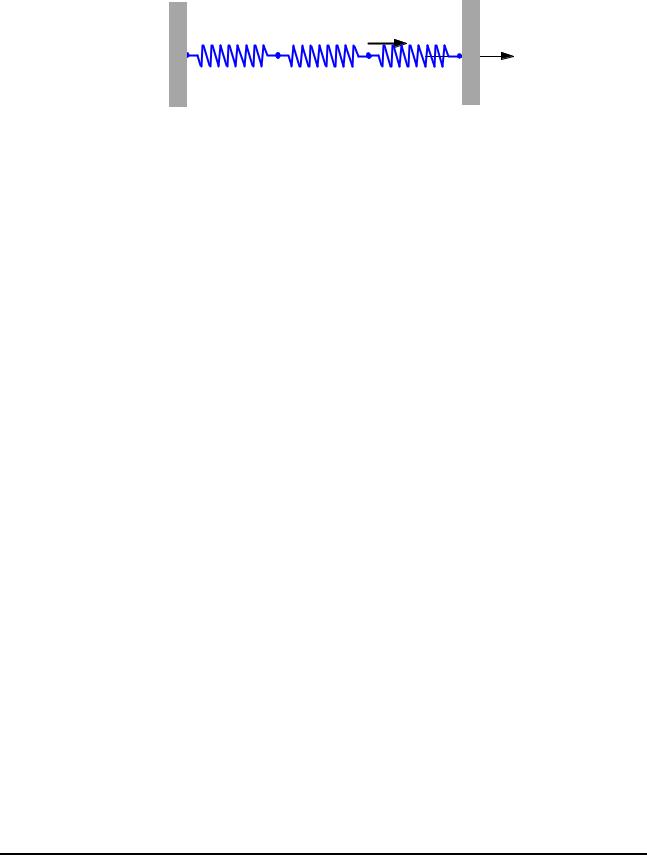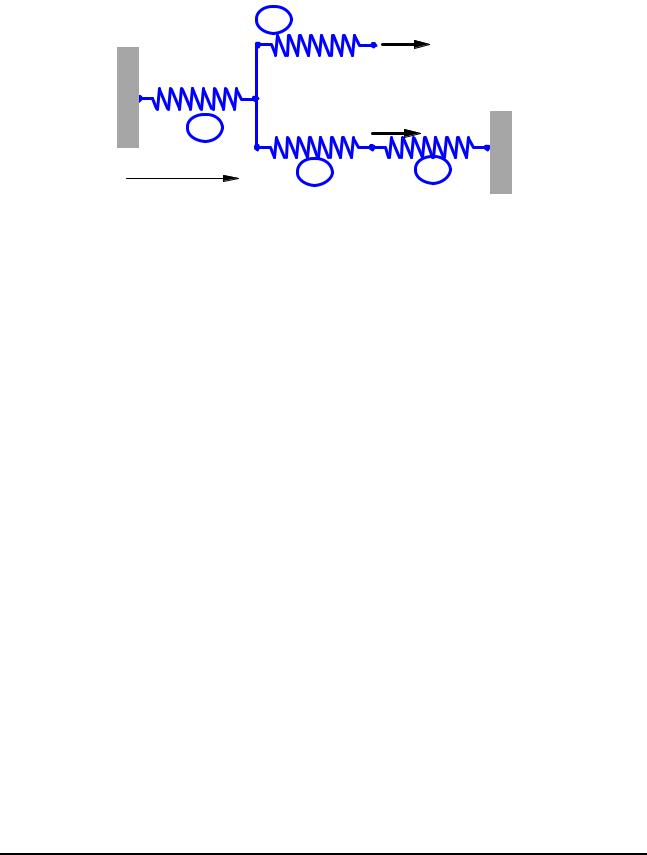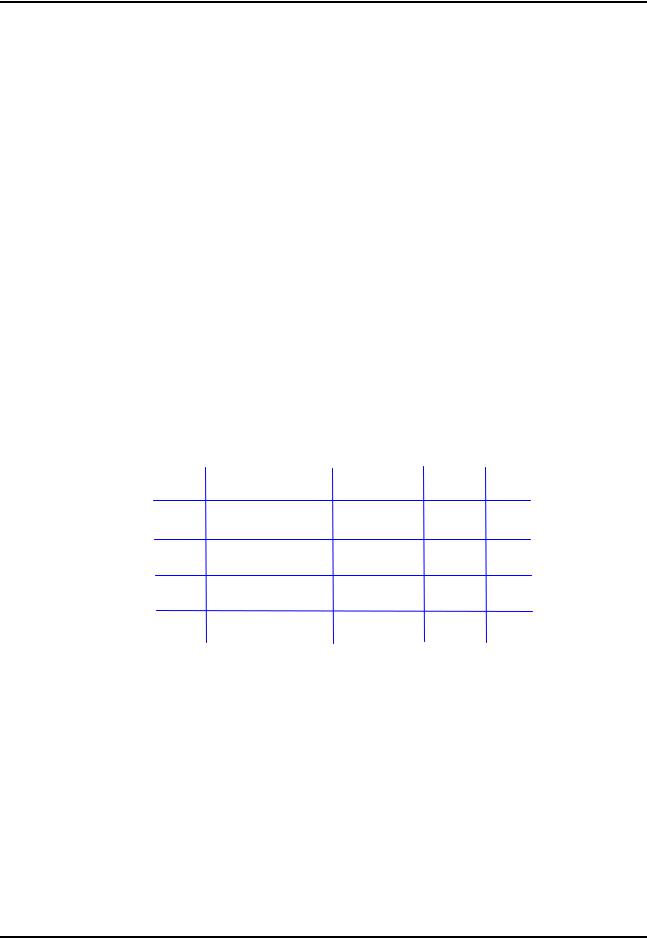
- •Copyright Notice
- •Table of Contents
- •Chapter 1. Introduction
- •I. Basic Concepts
- •Examples:
- •Why Finite Element Method?
- •Applications of FEM in Engineering
- •Examples:
- •A Brief History of the FEM
- •FEM in Structural Analysis (The Procedure)
- •Example:
- •Available Commercial FEM Software Packages
- •Objectives of This FEM Course
- •II. Review of Matrix Algebra
- •Linear System of Algebraic Equations
- •Matrix Addition and Subtraction
- •Scalar Multiplication
- •Matrix Multiplication
- •Transpose of a Matrix
- •Symmetric Matrix
- •Unit (Identity) Matrix
- •Determinant of a Matrix
- •Singular Matrix
- •Matrix Inversion
- •Examples:
- •Solution Techniques for Linear Systems of Equations
- •Positive Definite Matrix
- •Differentiation and Integration of a Matrix
- •Types of Finite Elements
- •III. Spring Element
- •One Spring Element
- •Spring System
- •Checking the Results
- •Notes About the Spring Elements
- •Example 1.1
- •Chapter 2. Bar and Beam Elements
- •I. Linear Static Analysis
- •II. Bar Element
- •Stiffness Matrix --- Direct Method
- •Stiffness Matrix --- A Formal Approach
- •Example 2.1
- •Example 2.2
- •Distributed Load
- •Bar Elements in 2-D and 3-D Space
- •2-D Case
- •Transformation
- •Stiffness Matrix in the 2-D Space
- •Element Stress
- •Example 2.3
- •Example 2.4 (Multipoint Constraint)
- •3-D Case
- •III. Beam Element
- •Simple Plane Beam Element
- •Direct Method
- •Formal Approach
- •3-D Beam Element
- •Example 2.5
- •Equivalent Nodal Loads of Distributed Transverse Load
- •Example 2.6
- •Example 2.7
- •FE Analysis of Frame Structures
- •Example 2.8
- •Chapter 3. Two-Dimensional Problems
- •I. Review of the Basic Theory
- •Plane (2-D) Problems
- •Stress-Strain-Temperature (Constitutive) Relations
- •Strain and Displacement Relations
- •Equilibrium Equations
- •Exact Elasticity Solution
- •Example 3.1
- •II. Finite Elements for 2-D Problems
- •A General Formula for the Stiffness Matrix
- •Constant Strain Triangle (CST or T3)
- •Linear Strain Triangle (LST or T6)
- •Linear Quadrilateral Element (Q4)
- •Quadratic Quadrilateral Element (Q8)
- •Example 3.2
- •Transformation of Loads
- •Stress Calculation
- •I. Symmetry
- •Types of Symmetry:
- •Examples:
- •Applications of the symmetry properties:
- •Examples:
- •Cautions:
- •II. Substructures (Superelements)
- •Physical Meaning:
- •Mathematical Meaning:
- •Advantages of Using Substructures/Superelements:
- •Disadvantages:
- •III. Equation Solving
- •Direct Methods (Gauss Elimination):
- •Iterative Methods:
- •Gauss Elimination - Example:
- •Iterative Method - Example:
- •IV. Nature of Finite Element Solutions
- •Stiffening Effect:
- •V. Numerical Error
- •VI. Convergence of FE Solutions
- •Type of Refinements:
- •Examples:
- •VII. Adaptivity (h-, p-, and hp-Methods)
- •Error Indicators:
- •Examples:
- •Chapter 5. Plate and Shell Elements
- •Applications:
- •Forces and Moments Acting on the Plate:
- •Stresses:
- •Relations Between Forces and Stresses
- •Thin Plate Theory ( Kirchhoff Plate Theory)
- •Examples:
- •Under uniform load q
- •Thick Plate Theory (Mindlin Plate Theory)
- •II. Plate Elements
- •Kirchhoff Plate Elements:
- •Mindlin Plate Elements:
- •Discrete Kirchhoff Element:
- •Test Problem:
- •Mesh
- •III. Shells and Shell Elements
- •Example: A Cylindrical Container.
- •Shell Theory:
- •Shell Elements:
- •Curved shell elements:
- •Test Cases:
- •Chapter 6. Solid Elements for 3-D Problems
- •I. 3-D Elasticity Theory
- •Stress State:
- •Strains:
- •Stress-strain relation:
- •Displacement:
- •Strain-Displacement Relation:
- •Equilibrium Equations:
- •Stress Analysis:
- •II. Finite Element Formulation
- •Displacement Field:
- •Stiffness Matrix:
- •III. Typical 3-D Solid Elements
- •Tetrahedron:
- •Hexahedron (brick):
- •Penta:
- •Element Formulation:
- •Solids of Revolution (Axisymmetric Solids)
- •Axisymmetric Elements
- •Applications
- •Chapter 7. Structural Vibration and Dynamics
- •I. Basic Equations
- •A. Single DOF System
- •B. Multiple DOF System
- •Example
- •II. Free Vibration
- •III. Damping
- •IV. Modal Equations
- •V. Frequency Response Analysis
- •VI. Transient Response Analysis
- •B. Modal Method
- •Cautions in Dynamic Analysis
- •Examples
- •Chapter 8. Thermal Analysis
- •Further Reading

Lecture Notes: Introduction to Finite Element Method |
Chapter 1. Introduction |
||||
Solving the equations, we obtain the displacements |
|||||
u |
|
|
2P / k |
|
|
|
2 |
= |
|
1 |
|
u3 |
2P / k1 + P / k |
2 |
|||
and the reaction force
F1 = −2P
Checking the Results
•Deformed shape of the structure
•Balance of the external forces
•Order of magnitudes of the numbers
Notes About the Spring Elements
•Suitable for stiffness analysis
•Not suitable for stress analysis of the spring itself
•Can have spring elements with stiffness in the lateral direction, spring elements for torsion, etc.
© 1997-2003 Yijun Liu, University of Cincinnati |
19 |

Lecture Notes: Introduction to Finite Element Method |
Chapter 1. Introduction |
Example 1.1
k1 |
k2 |
P |
k3 |
|
1 |
2 |
3 |
4 |
x |
|
Given: |
For the spring system shown above, |
|
|||
|
k1 |
= 100 N / mm, k2 |
= 200 N / mm, k3 |
= 100 N / mm |
|
|
P = 500 N, |
u1 = u4 = 0 |
|
||
Find: |
(a) the global stiffness matrix |
|
|||
|
(b) displacements of nodes 2 and 3 |
|
|||
|
(c) the reaction forces at nodes 1 and 4 |
|
|||
|
(d) the force in the spring 2 |
|
|||
Solution: |
|
|
|
|
|
(a) The element stiffness matrices are |
|
||||
|
k1 |
100 |
−100 |
(N/mm) |
(1) |
|
= |
|
|||
|
|
−100 |
100 |
|
|
|
k2 |
200 |
−200 |
(N/mm) |
(2) |
|
= |
|
|||
|
|
−200 |
200 |
|
|
|
k3 |
100 |
−100 |
(N/mm) |
(3) |
|
= |
|
|||
|
|
−100 |
100 |
|
|
© 1997-2003 Yijun Liu, University of Cincinnati |
20 |

Lecture Notes: Introduction to Finite Element Method |
Chapter 1. Introduction |
Applying the superposition concept, we obtain the global stiffness matrix for the spring system as
|
u1 |
u2 |
u3 |
u4 |
|
100 |
−100 |
0 |
0 |
|
|
−100 |
100 +200 |
−200 |
0 |
|
|
K = |
0 |
−200 |
200 +100 |
|
|
|
−100 |
||||
|
0 |
0 |
−100 |
100 |
|
|
|
||||
or
100 |
−100 |
0 |
0 |
|
|
−100 |
300 |
−200 |
0 |
|
|
K = |
0 |
−200 |
300 |
|
|
|
−100 |
||||
|
0 |
0 |
−100 |
100 |
|
|
|
||||
which is symmetric and banded.
Equilibrium (FE) equation for the whole system is
100 |
−100 |
0 |
0 |
u |
|
F |
|
|
||||
|
−100 |
300 |
−200 |
0 |
|
1 |
|
|
1 |
|
|
|
|
|
u2 |
|
|
0 |
|
(4) |
|||||
0 |
−200 |
300 |
|
|
u |
|
= |
P |
|
|||
|
−100 |
|
|
|
|
|
||||||
|
|
|
|
|
|
3 |
|
|
||||
|
0 |
0 |
−100 |
100 |
u |
|
F |
|
|
|||
|
|
|
|
|
|
4 |
|
|
4 |
|
|
|
(b) Applying the BC (u1 = u4 = 0) in Eq(4), or deleting the 1st and 4th rows and columns, we have
© 1997-2003 Yijun Liu, University of Cincinnati |
21 |

Lecture Notes: Introduction to Finite Element Method |
Chapter 1. Introduction |
|
300 |
−200 u2 |
|
0 |
|
|
−200 |
300 |
u |
|
= P |
(5) |
|
|
|
|
3 |
|
|
|
Solving Eq.(5), we obtain
u |
|
|
P / 250 |
2 |
(mm) |
(6) |
2 |
|
= |
|
= |
||
u3 |
|
3P / 500 |
3 |
|
|
|
(c)From the 1st and 4th equations in (4), we get the reaction forces F1 = −100u2 = −200 (N)
F4 = −100u3 = −300 (N)
(d)The FE equation for spring (element) 2 is
|
200 |
−200 ui |
fi |
|||
|
|
200 |
|
|
= |
|
−200 |
uj |
f j |
||||
Here i = 2, j = 3 for element 2. Thus we can calculate the spring force as
F = f j = − fi = [−200 |
u |
|
200] 2 |
|
|
|
u3 |
|
= [−200 |
2 |
|
200] |
||
|
3 |
|
= 200 (N) |
|
|
Check the results!
© 1997-2003 Yijun Liu, University of Cincinnati |
22 |

Lecture Notes: Introduction to Finite Element Method |
Chapter 1. Introduction |
Example 1.2
|
4 |
k4 |
|
k1 |
|
4 |
2 |
k2 |
1 |
||
|
x |
2 |
|
|
F 1
1
F 2 k3
3 |
3 |
5 |
Problem: For the spring system with arbitrarily numbered nodes and elements, as shown above, find the global stiffness matrix.
Solution:
First we construct the following
Element Connectivity Table
Element |
Node i (1) |
Node j (2) |
|
|
|
1 |
4 |
2 |
2 |
2 |
3 |
3 |
3 |
5 |
4 |
2 |
1 |
|
|
|
which specifies the global node numbers corresponding to the local node numbers for each element.
© 1997-2003 Yijun Liu, University of Cincinnati |
23 |

Lecture Notes: Introduction to Finite Element Method Chapter 1. Introduction
Then we can write the element stiffness matrices as follows
|
|
u4 |
u2 |
|
|
|
u2 |
u3 |
|
|||
k1 |
|
k |
|
− k |
|
k2 |
|
k |
|
− k |
|
|
= |
|
1 |
1 |
|
= |
|
2 |
|
2 |
|
||
|
− k1 |
k1 |
|
− k2 |
k2 |
|||||||
|
|
u3 |
u5 |
|
|
|
u2 |
u1 |
|
||||
k3 |
|
k |
3 |
− k |
3 |
|
k4 |
|
k |
4 |
− k |
4 |
|
= |
|
|
|
= |
|
|
|
||||||
|
− k3 |
k3 |
|
− k4 |
k4 |
||||||||
Finally, applying the superposition method, we obtain the global stiffness matrix as follows
|
u1 |
|
|
|
u2 |
|
|
u3 |
|
u4 |
|
u5 |
|
|
k4 |
|
|
|
− k4 |
|
0 |
|
0 |
|
0 |
|
|||
− k |
4 |
k |
1 |
+ k |
2 |
+ k |
4 |
− k |
2 |
− k |
1 |
0 |
|
|
|
|
|
|
|
|
|
|
|
||||||
K = 0 |
|
|
|
− k2 |
|
k2 + k3 |
0 |
|
− k3 |
|
||||
|
0 |
|
|
|
− k1 |
|
0 |
|
k1 |
|
0 |
|
||
|
|
|
|
|
|
|
|
|||||||
|
0 |
|
|
|
0 |
|
|
− k3 |
0 |
|
k3 |
|
||
|
|
|
|
|
|
|
|
|||||||
The matrix is symmetric, banded, but singular.
© 1997-2003 Yijun Liu, University of Cincinnati |
24 |
